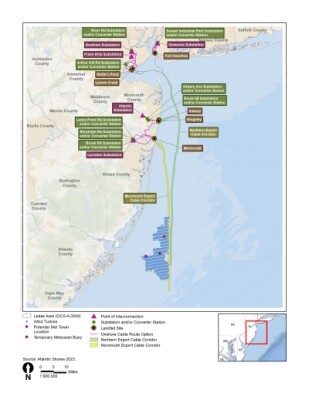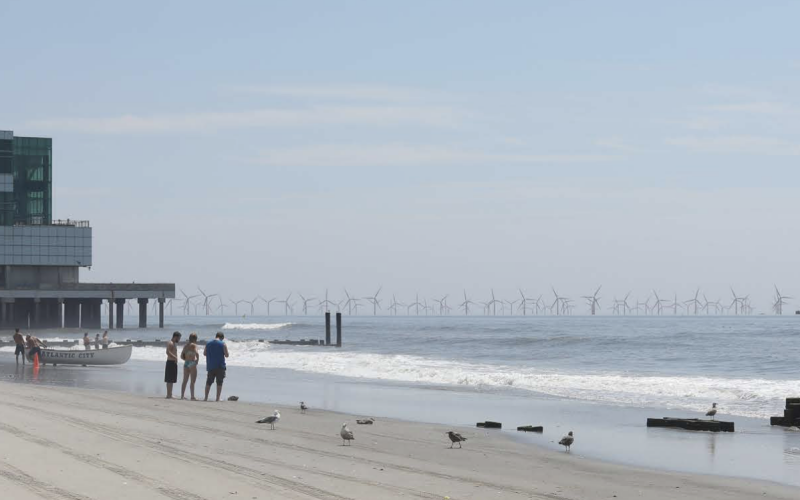The federal Bureau of Ocean Energy Management on March 18 opened two new environmental assessments of offshore wind power: one for the agency’s proposed Gulf of Maine wind energy areas, the other for the Atlantic Shores project off New Jersey.
Both proposals are hotly contested by ocean user groups, but supported by Northeast state political leaders along with the Biden administration. The processes opened March 18 with a “notice of intent” in the Federal Register, and come as the budding U.S. offshore wind industry remains under financial and supply-chain setbacks.
The Gulf of Maine wind energy area includes around 2 million acres off Maine, Massachusetts, and New Hampshire, from 23 mile to 92 miles offshore, according to BOEM. The agency says that is an 80 percent reduction from a much broader area initially examined by BOEM, and a further 43 percent down from an early draft plan.
BOEM officials say their process sought to avoid lobster and other fishing areas and habitats. In its own August 2023 summary report, the New England Fishermen’s Stewardship Association said BOEM should have conducted an environmental review before outlining wind energy areas, and warned of threats to lobster, haddock and endangered right whales.
In a joint statement Tuesday with 16 other New England fishing groups, NEFSA called BOEM's planning "the culmination of a rushed development process that is poorly informed on economic, scientific, environmental and cultural issues of paramount importance. Without adequate consideration of these issues, leasing in BOEM’s WEA designation should not be pursued."
Changes from an early draft document show some improvements, such as a new spatial modeling process that shows existing ocean uses, and removal of important lobster fishing areas from consideration, NEFSA says.
"Despite improvements, the Final WEA leaves a large area open to offshore wind development which directly imperils commercial fishing, sensitive habitats, and maritime communities that depend on the fishing industry," the group says.
Fishing conflicts also loom large for the Atlantic Shores project off New Jersey, planned for offshore of Long Beach Island south to Atlantic City – a longtime port for the state’s surf clam fishery. A Rutgers University study estimated the fleet could lose 25 percent of its landings from planned offshore wind development including Atlantic Shores.
The clam industry is already under stress from gradual shifts in the East Coast surf clam and ocean quahog resources toward deeper and cooler waters in response to climate change. Offshore wind advocates that kind of pressure on fisheries is another reason to push renewable energy development.
But clam fishermen have warned for years they simply cannot operate their heavy hydraulic dredge equipment safely around planned offshore wind turbine arrays. For safety they called for 2 nautical mile-spacing between turbine towers – twice the spacing proposed in projects – but BOEM and wind developers have said that would make the projects too expensive.
The 81,129-acre Atlantic Shores North lease is as close as 8.4 miles to New Jersey beaches including resort areas like Long Beach Island. It has brought on stiff, highly organized resistance from local groups directed at BOEM and New Jersey state officials, with legal challenges and coordinated social media campaigns.
BOEM’s March 18 opening of the environmental impact statement process brought renewed protests over potential visual impacts of future wind turbine arrays on the region’s tourism economy.
“The Atlantic Shores’ proposal currently includes installation of up to 157 wind turbine generators, eight offshore substations, one permanent meteorological tower, and two temporary metocean buoys - for a total of up to 168 offshore structures,” according to the BOEM announcement. The developers’ construction and operations plan “also proposes two potential export cable corridors that would make landfall at: (1) Sea Girt, New Jersey, and (2) in either the New York City area or near Asbury Park, New Jersey,” according to the agency.

That new footnote brought a response over the weekend from Robert Stern, president of the Save Long Beach Island group – and a call for project opponents to prepare for a prolonged lgal battle.
“To add insult to injury, it appears from the map below that they will be taking all or some of the electric power from the Atlantic Shores North Project (and/or the Atlantic Shores South project) up the New Jersey coast to New York,” Stern wrote, referring to a BOEM graphic, in an email to supporters and reporters. “If so, this is truly inequitable because LBI and New Jersey would bear the adverse property value, rental, tourism, and other impacts of the turbine projects, while New York would get the benefit of the power.”
Stern said the group has recently filed a new notice of Intent to sue BOEM “under the Endangered Species Act, and plan to file substantial additional litigation on the Atlantic Shores South project when it is approved in May of this year.”
“Engaging in the environmental review process and pursuing litigation on the Atlantic Shores North project will require new substantial monetary support as it will have a distinct environmental impact statement (EIS) and other permit approvals,” Stern told supporters. “Although the filing of legal complaints on that project may be nine months away when that final EIS is done, we need to build an adequate war chest for that project.”
“So, for anyone who thought you could escape this madness by remaining uninvolved, that is unfortunately not the case. I would suggest to those concerned about the Atlantic Shores North project that now is the time to step up.”








